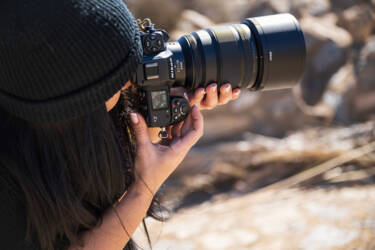NIKKOR Z DX 24mm f/1.7: “The perfect prime for pictures on the fly”

The new NIKKOR Z DX 24mm f/1.7 – the very first Z mount DX prime lens – is put through its paces by Nikon School’s Ricci Chera
Nikon School training specialist and wildlife photographer Ricci Chera was one of the first to use the new NIKKOR Z DX 24mm f/1.7. We followed him to the Peak District, England, where he took pictures of the glorious British countryside. Here, he gives us the lowdown on the new DX lens.
Ricci Chera

First impressions
This small, lightweight lens is very easy to carry. It’s not too bulky, even with the lens hood on, and has been designed to have the hood on the entire time. I see this as a little muffin lens as it’s only slightly wider than pancake lenses. With a weight of 135g, it can be left on your camera all day – I’ve been using mine on my Nikon Z fc.

90-Second NIKKOR: NIKKOR Z DX 24mm f/1.7 in action
Click the button to play
Best use cases
If you want a good, all-rounder lens that’s ideal for taking pictures on the fly, this is the one. It’s the perfect next level lens for beginners wanting to invest in their first prime, as an aperture of f/1.7 allows for the creation of beautiful background bokeh (blur) and is fundamental in low-light situations, too.
This lens is excellent for a photographer who would like to have a 35mm equivalent (great for street, architecture, travel, and portraits) as DX 24mm is an almost equivalent of 35mm. For a deep dive into focal length, click here


The benefits of f/1.7 aperture
An aperture of f/1.7 allows more light into the sensor. When the sensor receives more light, you’ll take higher quality photographs, especially in low-light situations, such as shooting in the evening or at an inside event. Plus, if you’ve ever seen a portrait image of a subject that’s nice and sharp with a blurry background, that’s caused by the depth-of-field effect. A wide f/1.7 aperture creates a shallow depth of field, creating separation between subject and background.
Get up close to your subject and take macro shots of flowers and insects, too. It’s not specifically a macro lens, but you are in a position where you can get quite close to subjects – the minimum focusing distance is only 0.18m.


A lovely trio of lenses would be…
For me, I take my Nikon Z fc everywhere, even if bring my other full-frame cameras (I have the Z 8 and Z 9). I would almost always have one lens on my DX camera and then bring a couple of zoom lenses. If you want a small collection of lenses, ideally, you’d have an ultra-wide-angle lens (try the NIKKOR Z DX 12-28mm f/3.5-5.6 PZ VR), a good middle lens like this prime, and then a zoom lens (such as the NIKKOR Z DX 50-200mm f/4.5-6.3 VR). You miss out the shallow depth of field with the zooms because the aperture isn’t as wide, so this prime sits really nicely between the two zoom lenses and gives you that extra ability in low light.


Ricci Chera’s key tips
Move your feet
I love the fixed focal length a prime provides. Beginner photographers often forget to move their legs as it’s so easy to just zoom in and out. With a prime lens, you have to shoot with intention and fix yourself into how you want the shot to look. Move your feet and find new perspectives.
Experiment on a FX, full-frame body
While primarily a DX lens, I would encourage using this lens on a FX body. When you’re taking stills using a DX lens on a FX body it will crop, but you can use the lens the same way you would on a DX camera. The only difference is the slight drop in megapixel count. Full-frame cameras such as the Z 6II or the Z 5 crop their video in 4K 60fps, so you’re already in a DX crop when recording video – which makes the NIKKOR Z DX 24mm f/1.7 a really good prime for taking video (we explain why in more detail here).

Know when to use f/1.7 and when not to use it
The NIKKOR Z DX 24mm f/1.7 has a minimum aperture of f/11. Just because you have a prime lens that allows you to shoot at f/1.7 doesn’t mean you need to take every single picture at f/1.7. There will be times where that shallow depth of field and blurry background look beautiful. And then there will be times where you might want to take a picture where everything is super sharp – here, you will be stopping down to f/5.6 or f/8 or even f/11. If you are trying to have a subject in your foreground, and you want to separate that subject from the background, then that’s where that f/1.7 can help you.
Ultimately, what I love about the lens is…
The design! It’s light, sleek and you can just leave it on the camera, and it’ll be ready when you are.
Discover NIKKOR lenses
Featured products
More in travel and landscape
These four methods will elevate your landscape photography
9 camera tricks for creative beach photography

Unlock greater creativity







